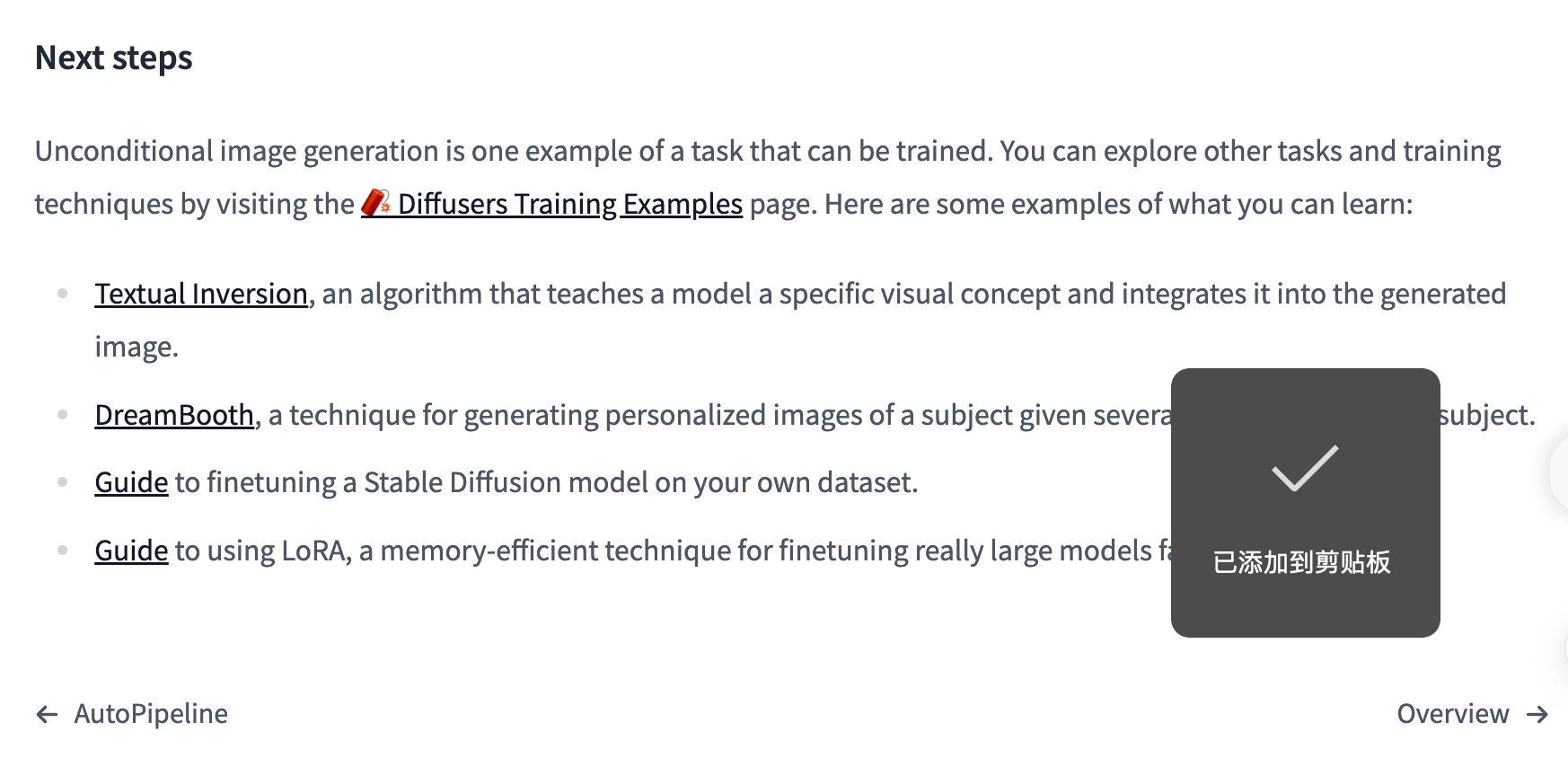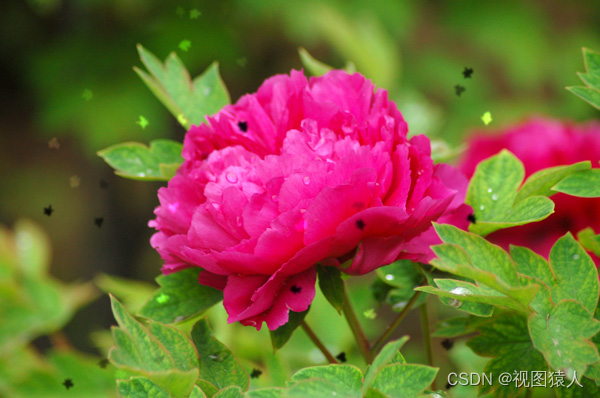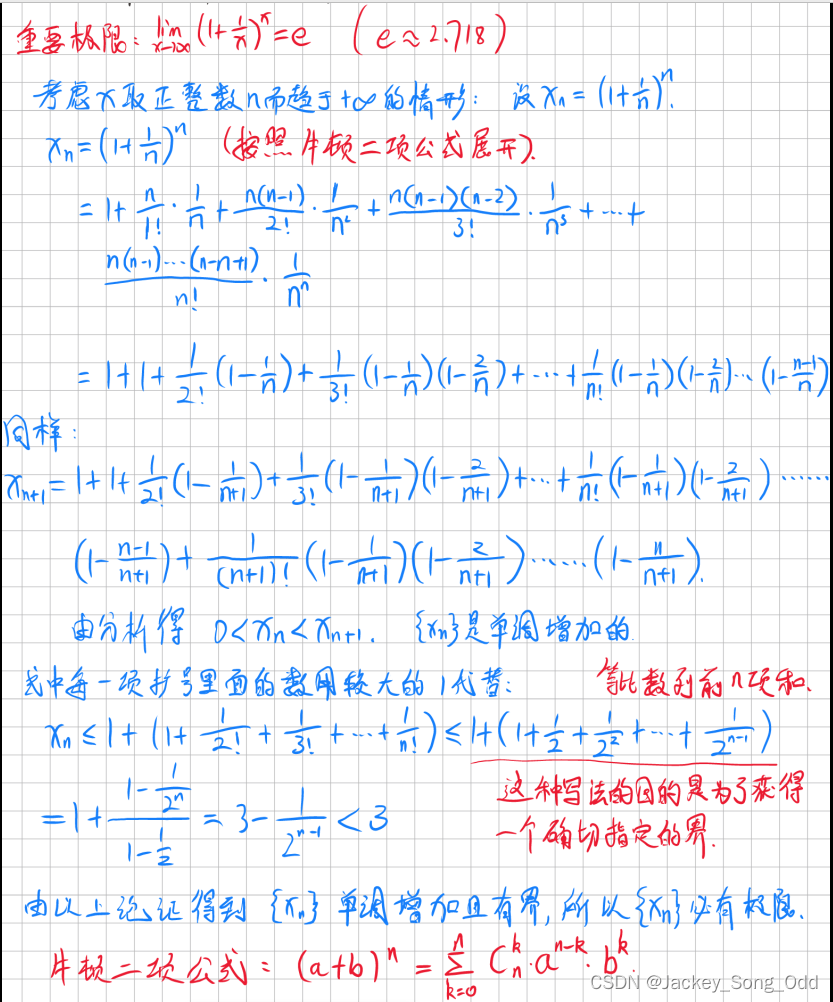文章目录
- 01 Tutorial
- Deconstruct a basic pipeline
- Deconstruct the Stable Diffusion pipeline
- Autopipeline
- Train a diffusion model
相关链接:
GitHub: https://github.com/huggingface/diffusers
官方教程:https://huggingface.co/docs/diffusers/tutorials/tutorial_overview
StableDiffuson: https://huggingface.co/blog/stable_diffusion#how-does-stable-diffusion-work
01 Tutorial
Diffusers被设计成一个用户友好和灵活的工具箱,用于构建适合您用例的扩散系统。工具箱的核心是模型和调度器。为了方便,DiffusionPipeline将这些组件捆绑在一起,你也可以解绑pipeline,分别使用模型和调度程序来创建新的扩散系统。
在本教程中,您将学习如何使用模型和调度器来组装用于推理的扩散系统,从基本pipeline开始,然后进展到Stable Diffusion pipeline.
Deconstruct a basic pipeline
from diffusers import DDPMPipeline
ddpm = DDPMPipeline.from_pretrained("google/ddpm-cat-256", use_safetensors=True).to("cuda")
image = ddpm(num_inference_steps=25).images[0]
image
为了分别用模型和调度器重新创建pipeline,下面是自己编写去噪过程的展示。
# Load the model and scheduler
from diffusers import DDPMScheduler, UNet2DModel
scheduler = DDPMScheduler.from_pretrained("google/ddpm-cat-256")
model = UNet2DModel.from_pretrained("google/ddpm-cat-256", use_safetensors=True).to("cuda")
# Set the number of timesteps to run the denoising process for
scheduler.set_timesteps(50)
# Create some random noise with the same shape as the desired output:
import torch
sample_size = model.config.sample_size
noise = torch.randn((1, 3, sample_size, sample_size)).to("cuda")
# Write a loop to iterate over the timesteps.
input = noise
for t in scheduler.timesteps:
with torch.no_grad():
noisy_residual = model(input, t).sample
previous_noisy_sample = scheduler.step(noisy_residual, t, input).prev_sample
input = previous_noisy_sample
# This is the entire denoising process, and you can use this same pattern to write any diffusion system.
# The last step is to convert the denoised output into an image:
from PIL import Image
import numpy as np
image = (input / 2 + 0.5).clamp(0, 1).squeeze()
image = (image.permute(1, 2, 0) * 255).round().to(torch.uint8).cpu().numpy()
image = Image.fromarray(image)
Deconstruct the Stable Diffusion pipeline
Stable Diffusion is a text-to-image latent diffusion model. It is called a latent diffusion model because it works with a lower-dimensional representation of the image instead of the actual pixel space, which makes it more memory efficient.
The encoder compresses the image into a smaller representation, and a decoder to convert the compressed representation back into an image.
For text-to-image models, you’ll need a tokenizer and an encoder to generate text embeddings. From the previous example, you already know you need a UNet model and a scheduler.
The Stable Diffusion model has three separate pretrained models:
from PIL import Image
import torch
from transformers import CLIPTextModel, CLIPTokenizer
from diffusers import AutoencoderKL, UNet2DConditionModel, PNDMScheduler
vae = AutoencoderKL.from_pretrained("CompVis/stable-diffusion-v1-4", subfolder="vae", use_safetensors=True)
tokenizer = CLIPTokenizer.from_pretrained("CompVis/stable-diffusion-v1-4", subfolder="tokenizer")
text_encoder = CLIPTextModel.from_pretrained(
"CompVis/stable-diffusion-v1-4", subfolder="text_encoder", use_safetensors=True
)
unet = UNet2DConditionModel.from_pretrained(
"CompVis/stable-diffusion-v1-4", subfolder="unet", use_safetensors=True
)
选择scheduler:
from diffusers import UniPCMultistepScheduler
scheduler = UniPCMultistepScheduler.from_pretrained("CompVis/stable-diffusion-v1-4", subfolder="scheduler")
为了加速推理,将模型移动到GPU,因为与调度程序不同,它们具有可训练的权重:
torch_device = "cuda"
vae.to(torch_device)
text_encoder.to(torch_device)
unet.to(torch_device)
参数设置
prompt = ["a photograph of an astronaut riding a horse"]
height = 512 # default height of Stable Diffusion
width = 512 # default width of Stable Diffusion
num_inference_steps = 25 # Number of denoising steps
guidance_scale = 7.5 # Scale for classifier-free guidance
generator = torch.manual_seed(0) # Seed generator to create the inital latent noise
batch_size = len(prompt)
Tokenize the text and generate the embeddings from the prompt:
text_input = tokenizer(
prompt, padding="max_length", max_length=tokenizer.model_max_length, truncation=True, return_tensors="pt"
)
with torch.no_grad():
text_embeddings = text_encoder(text_input.input_ids.to(torch_device))[0]
max_length = text_input.input_ids.shape[-1]
uncond_input = tokenizer([""] * batch_size, padding="max_length", max_length=max_length, return_tensors="pt")
uncond_embeddings = text_encoder(uncond_input.input_ids.to(torch_device))[0]
text_embeddings = torch.cat([uncond_embeddings, text_embeddings])
创建随机噪声
latents = torch.randn(
(batch_size, unet.in_channels, height // 8, width // 8),
generator=generator,
)
latents = latents.to(torch_device)
latents = latents * scheduler.init_noise_sigma
denoising loop 包含三个内容:
- Set the scheduler’s timesteps to use during denoising.
- Iterate over the timesteps.
- At each timestep, call the UNet model to predict the noise residual and pass it to the scheduler to compute the previous noisy sample.
from tqdm.auto import tqdm
scheduler.set_timesteps(num_inference_steps)
for t in tqdm(scheduler.timesteps):
# expand the latents if we are doing classifier-free guidance to avoid doing two forward passes.
latent_model_input = torch.cat([latents] * 2)
latent_model_input = scheduler.scale_model_input(latent_model_input, timestep=t)
# predict the noise residual
with torch.no_grad():
noise_pred = unet(latent_model_input, t, encoder_hidden_states=text_embeddings).sample
# perform guidance
noise_pred_uncond, noise_pred_text = noise_pred.chunk(2)
noise_pred = noise_pred_uncond + guidance_scale * (noise_pred_text - noise_pred_uncond)
# compute the previous noisy sample x_t -> x_t-1
latents = scheduler.step(noise_pred, t, latents).prev_sample
最后一步是使用vae将潜在表示解码成图像,并得到带有样本的解码输出:
# scale and decode the image latents with vae
latents = 1 / 0.18215 * latents
with torch.no_grad():
image = vae.decode(latents).sample
convert the image to a PIL.Image to see your generated image!
image = (image / 2 + 0.5).clamp(0, 1).squeeze()
image = (image.permute(1, 2, 0) * 255).to(torch.uint8).cpu().numpy()
images = (image * 255).round().astype("uint8")
image = Image.fromarray(image)
Autopipeline
旨在简化 Diffusers中的各种管道。它是一个通用的、任务优先的管道,可以让您专注于任务。autopipeline自动检测要使用的正确管道类,这使得在不知道特定管道类名称的情况下更容易为任务加载检查点。 支持text-to-image, image-to-image and inpainting.
本教程向您展示如何使用autoppipeline在给定预训练权值的情况下,自动推断要为特定任务加载的管道类。
Text-to-image
from diffusers import AutoPipelineForText2Image
import torch
pipeline = AutoPipelineForText2Image.from_pretrained(
"runwayml/stable-diffusion-v1-5", torch_dtype=torch.float16, use_safetensors=True
).to("cuda")
prompt = "peasant and dragon combat, wood cutting style, viking era, bevel with rune"
image = pipeline(prompt, num_inference_steps=25).images[0]
Image-to-image
from diffusers import AutoPipelineForImage2Image
pipeline = AutoPipelineForImage2Image.from_pretrained(
"runwayml/stable-diffusion-v1-5",
torch_dtype=torch.float16,
use_safetensors=True,
).to("cuda")
prompt = "a portrait of a dog wearing a pearl earring"
url = "https://upload.wikimedia.org/wikipedia/commons/thumb/0/0f/1665_Girl_with_a_Pearl_Earring.jpg/800px-1665_Girl_with_a_Pearl_Earring.jpg"
response = requests.get(url)
image = Image.open(BytesIO(response.content)).convert("RGB")
image.thumbnail((768, 768))
image = pipeline(prompt, image, num_inference_steps=200, strength=0.75, guidance_scale=10.5).images[0]
Inpainting
from diffusers import AutoPipelineForInpainting
from diffusers.utils import load_image
pipeline = AutoPipelineForInpainting.from_pretrained(
"stabilityai/stable-diffusion-xl-base-1.0", torch_dtype=torch.float16, use_safetensors=True
).to("cuda")
img_url = "https://raw.githubusercontent.com/CompVis/latent-diffusion/main/data/inpainting_examples/overture-creations-5sI6fQgYIuo.png"
mask_url = "https://raw.githubusercontent.com/CompVis/latent-diffusion/main/data/inpainting_examples/overture-creations-5sI6fQgYIuo_mask.png"
init_image = load_image(img_url).convert("RGB")
mask_image = load_image(mask_url).convert("RGB")
prompt = "A majestic tiger sitting on a bench"
image = pipeline(prompt, image=init_image, mask_image=mask_image, num_inference_steps=50, strength=0.80).images[0]
如果你传递了一个可选参数——比如禁用安全检查器——给原始管道,这个参数也会传递给新的管道:
from diffusers import AutoPipelineForText2Image, AutoPipelineForImage2Image
pipeline_text2img = AutoPipelineForText2Image.from_pretrained(
"runwayml/stable-diffusion-v1-5",
torch_dtype=torch.float16,
use_safetensors=True,
requires_safety_checker=False,
).to("cuda")
pipeline_img2img = AutoPipelineForImage2Image.from_pipe(pipeline_text2img)
print(pipe.config.requires_safety_checker)
"False"
也可以对它进行改写
pipeline_img2img = AutoPipelineForImage2Image.from_pipe(pipeline_text2img, requires_safety_checker=True, strength=0.3)
Train a diffusion model
本教程将教你如何从头开始训练unet2d模型在史密森尼蝴蝶数据集的一个子集上生成自己的蝴蝶。
构造training configuration
from dataclasses import dataclass
@dataclass
class TrainingConfig:
image_size = 128 # the generated image resolution
train_batch_size = 16
eval_batch_size = 16 # how many images to sample during evaluation
num_epochs = 50
gradient_accumulation_steps = 1
learning_rate = 1e-4
lr_warmup_steps = 500
save_image_epochs = 10
save_model_epochs = 30
mixed_precision = "fp16" # `no` for float32, `fp16` for automatic mixed precision
output_dir = "ddpm-butterflies-128" # the model name locally and on the HF Hub
push_to_hub = True # whether to upload the saved model to the HF Hub
hub_private_repo = False
overwrite_output_dir = True # overwrite the old model when re-running the notebook
seed = 0
config = TrainingConfig()
加载数据集
from datasets import load_dataset
config.dataset_name = "huggan/smithsonian_butterflies_subset"
dataset = load_dataset(config.dataset_name, split="train")
Datasets使用Image特性自动解码图像数据并将其加载为PIL。我们可以想象的图像:
import matplotlib.pyplot as plt
fig, axs = plt.subplots(1, 4, figsize=(16, 4))
for i, image in enumerate(dataset[:4]["image"]):
axs[i].imshow(image)
axs[i].set_axis_off()
fig.show()
这些图像的大小都不一样,所以你需要先对它们进行预处理:
from torchvision import transforms
preprocess = transforms.Compose(
[
transforms.Resize((config.image_size, config.image_size)),
transforms.RandomHorizontalFlip(),
transforms.ToTensor(),
transforms.Normalize([0.5], [0.5]),
]
)
def transform(examples):
images = [preprocess(image.convert("RGB")) for image in examples["image"]]
return {"images": images}
dataset.set_transform(transform)
import torch
train_dataloader = torch.utils.data.DataLoader(dataset, batch_size=config.train_batch_size, shuffle=True)
Create a UNet2DModel
from diffusers import UNet2DModel
model = UNet2DModel(
sample_size=config.image_size, # the target image resolution
in_channels=3, # the number of input channels, 3 for RGB images
out_channels=3, # the number of output channels
layers_per_block=2, # how many ResNet layers to use per UNet block
block_out_channels=(128, 128, 256, 256, 512, 512), # the number of output channels for each UNet block
down_block_types=(
"DownBlock2D", # a regular ResNet downsampling block
"DownBlock2D",
"DownBlock2D",
"DownBlock2D",
"AttnDownBlock2D", # a ResNet downsampling block with spatial self-attention
"DownBlock2D",
),
up_block_types=(
"UpBlock2D", # a regular ResNet upsampling block
"AttnUpBlock2D", # a ResNet upsampling block with spatial self-attention
"UpBlock2D",
"UpBlock2D",
"UpBlock2D",
"UpBlock2D",
),
)
快速检查样本图像形状与模型输出形状是否匹配:
sample_image = dataset[0]["images"].unsqueeze(0)
print("Input shape:", sample_image.shape)
print("Output shape:", model(sample_image, timestep=0).sample.shape)
Create a scheduler
让我们来看看DDPMScheduler,并使用add_noise方法为之前的sample_image添加一些随机噪声:
import torch
from PIL import Image
from diffusers import DDPMScheduler
noise_scheduler = DDPMScheduler(num_train_timesteps=1000)
noise = torch.randn(sample_image.shape)
timesteps = torch.LongTensor([50])
noisy_image = noise_scheduler.add_noise(sample_image, noise, timesteps)
Image.fromarray(((noisy_image.permute(0, 2, 3, 1) + 1.0) * 127.5).type(torch.uint8).numpy()[0])
该模型的训练目标是预测添加到图像中的噪声。这一步的损失可以计算为:
import torch.nn.functional as F
noise_pred = model(noisy_image, timesteps).sample
loss = F.mse_loss(noise_pred, noise)
Train The model
到目前为止,您已经拥有了开始训练模型的大部分部分,剩下的就是将所有内容组合在一起。
from diffusers.optimization import get_cosine_schedule_with_warmup
optimizer = torch.optim.AdamW(model.parameters(), lr=config.learning_rate)
lr_scheduler = get_cosine_schedule_with_warmup(
optimizer=optimizer,
num_warmup_steps=config.lr_warmup_steps,
num_training_steps=(len(train_dataloader) * config.num_epochs),
)
# evaluation
# For evaluation, you can use the DDPMPipeline to generate a batch of sample images and save it as a grid:
from diffusers import DDPMPipeline
from diffusers.utils import make_image_grid
import math
import os
def evaluate(config, epoch, pipeline):
# Sample some images from random noise (this is the backward diffusion process).
# The default pipeline output type is `List[PIL.Image]`
images = pipeline(
batch_size=config.eval_batch_size,
generator=torch.manual_seed(config.seed),
).images
# Make a grid out of the images
image_grid = make_image_grid(images, rows=4, cols=4)
# Save the images
test_dir = os.path.join(config.output_dir, "samples")
os.makedirs(test_dir, exist_ok=True)
image_grid.save(f"{test_dir}/{epoch:04d}.png")
训练循环:
def train_loop(config, model, noise_scheduler, optimizer, train_dataloader, lr_scheduler):
# Initialize accelerator and tensorboard logging
accelerator = Accelerator(
mixed_precision=config.mixed_precision,
gradient_accumulation_steps=config.gradient_accumulation_steps,
log_with="tensorboard",
project_dir=os.path.join(config.output_dir, "logs"),
)
if accelerator.is_main_process:
if config.push_to_hub:
repo_name = get_full_repo_name(Path(config.output_dir).name)
repo = Repository(config.output_dir, clone_from=repo_name)
elif config.output_dir is not None:
os.makedirs(config.output_dir, exist_ok=True)
accelerator.init_trackers("train_example")
# Prepare everything
# There is no specific order to remember, you just need to unpack the
# objects in the same order you gave them to the prepare method.
model, optimizer, train_dataloader, lr_scheduler = accelerator.prepare(
model, optimizer, train_dataloader, lr_scheduler
)
global_step = 0
# Now you train the model
for epoch in range(config.num_epochs):
progress_bar = tqdm(total=len(train_dataloader), disable=not accelerator.is_local_main_process)
progress_bar.set_description(f"Epoch {epoch}")
for step, batch in enumerate(train_dataloader):
clean_images = batch["images"]
# Sample noise to add to the images
noise = torch.randn(clean_images.shape).to(clean_images.device)
bs = clean_images.shape[0]
# Sample a random timestep for each image
timesteps = torch.randint(
0, noise_scheduler.config.num_train_timesteps, (bs,), device=clean_images.device
).long()
# Add noise to the clean images according to the noise magnitude at each timestep
# (this is the forward diffusion process)
noisy_images = noise_scheduler.add_noise(clean_images, noise, timesteps)
with accelerator.accumulate(model):
# Predict the noise residual
noise_pred = model(noisy_images, timesteps, return_dict=False)[0]
loss = F.mse_loss(noise_pred, noise)
accelerator.backward(loss)
accelerator.clip_grad_norm_(model.parameters(), 1.0)
optimizer.step()
lr_scheduler.step()
optimizer.zero_grad()
progress_bar.update(1)
logs = {"loss": loss.detach().item(), "lr": lr_scheduler.get_last_lr()[0], "step": global_step}
progress_bar.set_postfix(**logs)
accelerator.log(logs, step=global_step)
global_step += 1
# After each epoch you optionally sample some demo images with evaluate() and save the model
if accelerator.is_main_process:
pipeline = DDPMPipeline(unet=accelerator.unwrap_model(model), scheduler=noise_scheduler)
if (epoch + 1) % config.save_image_epochs == 0 or epoch == config.num_epochs - 1:
evaluate(config, epoch, pipeline)
if (epoch + 1) % config.save_model_epochs == 0 or epoch == config.num_epochs - 1:
if config.push_to_hub:
repo.push_to_hub(commit_message=f"Epoch {epoch}", blocking=True)
else:
pipeline.save_pretrained(config.output_dir)








